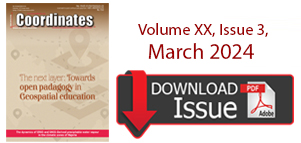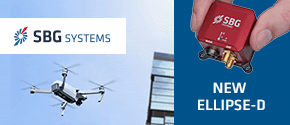| Imaging | |
IMAGING
Airbus adds extra precision to Sentinel-3 satellite altimetry
A new highly precise MicroWave Radiometer (MWR) built by Airbus is ready to start operations after the launch of the Sentinel-3B satellite built by Thales Alenia Space as prime contractor for this program. It is one of the essential instruments of the Sentinel3 spacecraft, measuring atmospheric humidity as supplementary information for tropospheric path correction of the altimeter signal. In addition, MWR data is useful to measure surface emissivity and soil moisture overland, surface energy budget investigations which support atmospheric studies and for ice characterization. These corrected measurements along with a digital elevation mode help the radar altimeter to work in SAR (Synthetic Aperture Radar) mode, which is much more precise and provides much better spatial resolution along the track. The data produced will allow scientists to monitor sea-level changes, sea surface temperature, manage water quality,and track marine pollution and biological productivity. It will also provide a land monitoring service with wildfire detection, land cover mapping and vegetation health monitoring. This will provide complementary data to the Sentinel-2 multispectral optical mission.
China launches five commercial remote sensing satellites
China successfully completed its twelfth orbital launch of 2018, sending five small Zhuhai-1 remote sensing satellites into orbit.
Aboard the rocket were one video and four hyperspectral Earth-observation satellites for the Zhuhai Orbita constellation, designated as OHS-01, 02, 03 and 04 (hyperspectral) and OVS-2.
The OVS-2 is an upgraded version of the OVS-1A and OVS-1B satellites launched in June 2017, with spatial resolution of 90 centimeters at an altitude of 500 km and a swath width of 22.5 km. The OHS satellites – China’s first commercial hyperspectral satellites in orbit – have a resolution of 10 meters and can complete global coverage in around five days. http://spacenews.com
US government considers charging for popular EO data
The US government is considering whether to charge for access to two widely used sources of remote-sensing imagery: the Landsat satellites operated by the US Geological Survey (USGS) and an aerial-survey programme run by the Department of Agriculture (USDA).
Officials at the Department of the Interior, which oversees the USGS, have asked a federal advisory committee to explore how putting a price on Landsat data might affect scientists and other users; the panel’s analysis is due later this year. And the USDA is contemplating a plan to institute fees for its data as early as 2019. www.nature.com
Chinese space-based RS technology helps discover heritage in Tunisia
Ten new archeological sites in southern Tunisia were discovered using Chinese space-based remote sensing technology. The archaeological sites, dating back to ancient Roman times, are located in three Tunisian provinces — Gafsa, Tataouine and Medenine, said Tunisian Culture Minister Mohamed Zine El-Abidine at a press conference. www.ecns.cn
SimActive automates drone data processing
SimActive Inc has announced increased drone data automation in Correlator3D™. New automated profiles include configurable options with a predefined set of parameters to deliver superior results from the first project onward. As an example, the “Quick Project Overview” enables users to rapidly process and generate results while still in the field for quality control. Additional options include “Standard UAV”, “Classic Photogrammetric”, and “Fast Ortho.” www.simactive.com
China to launch two remote sensing satellites for Pakistan in June
China will launch two remote sensing satellites for Pakistan in June, the China Academy of Launch Vehicle Technology (CALVT) said.
It will be the first international commercial launch for a Long March- 2C rocket after it carried Motorola’s Iridium satellites into orbit in 1999.
The rocket will also carry the China- France Oceanography Satellite into space in September this year, state-run Xinhua news agency reported quoting CALVT. www.hindustantimes.com
Belarus eyes launch of its second remote sensing satellite
Belarus is planning to launch its second remote sensing satellite. However, the officials have not yet revealed the exact launch date of the spacecraft.
The satellite, named BKA-2, will be a remote sensing spacecraft, built by the Russian corporation VNIIEM (this was confirmed recently by the Belarusian Prime Minister Andrei Kobyakov). www.spaceflightinsider.com
Global carbon dioxide maps produced by Chinese observation satellite
An Earth observation satellite called TanSat has produced its first global carbon dioxide maps. TanSat was launched by a collaborative team of researchers in China, and these maps are the first steps to provide global carbon dioxide measurements for future climate change research.
The maps, based on data collected in April and July 2017, are published in the latest edition of the journal Advances in Atmospheric Sciences.
TanSat, launched in December 2016, is the third satellite in orbit capable of monitoring carbon dioxide with hyperspectral imaging, and it is China’s first greenhouse gas monitoring satellite. The satellite measures not only the presence of carbon dioxide, but also carbon dioxide flux—the source and sink of carbon dioxide on Earth’s surface.
The satellite can measure carbon dioxide’s absorption in the nearinfrared zone for a better picture of carbon dioxide’s behavior on and around Earth. The TanSat maps were completed within a year of the satellite’s launch. https://phys.org
Boeing and JAXA to Flight-test Technology to Improve Safety
Boeing and the Japan Aerospace Exploration Agency (JAXA) will flight-test Long-range Light Detection and Ranging (LIDAR) technology next year. This remote-sensing technology could help commercial airplane pilots better detect and avoid weather disturbances to improve flight safety.
Boeing and JAXA have been collaborating on the integration of LIDAR technology into a commercial airplane platform since 2010. The JAXA LIDAR technology of fers the potential to accurately measure winds as much as 17.5 kilometers in front of airplanes and provide pilots with sufficient time to take appropriate action to avoid wind shear and clear air turbulence, which does not have any visual cues such as clouds. www.boeing.com
Deimos Imaging awarded GSA contract
Deimos Imaging and UrtheCast have been awarded a GSA Multiple Award Schedule (MAS) 070 contract by the U.S. General Services Administration (GSA), the procurement arm of the federal government.
This is the first time that a European company in Earth observation services has been awarded such a contract in the U.S., making Deimos Imaging’s full portfolio of products and services available to all U.S. government agencies.











 (No Ratings Yet)
(No Ratings Yet)




Leave your response!